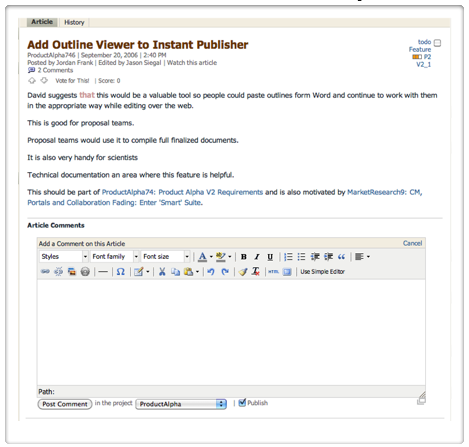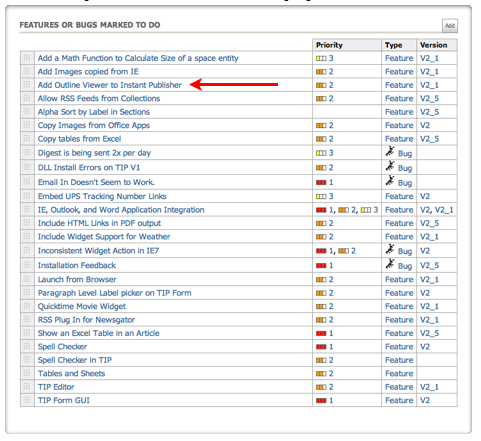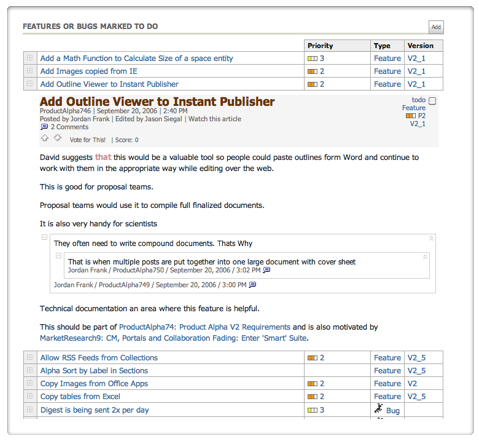Q: How do I link to an Excel file? A: Why Would you Do That?
I talked to two customers yesterday, both who came to me with some questions about attaching and linking to excel files. Easy enough, but before responding with a simple answer I challenged them: Why are you using Excel?
Pages vs. Rows, Tags vs. Columns
In both cases, we agreed on a better approach using page in Traction instead of rows in Excel, and a simple tagging strategy instead of columns in excel.
The first case was a customer at a state level Department of Health. Her Excel sheet had a simple list of 20 rows, each describing part of a work plan. There was very little sort criteria, except perhaps a way to scan and see which requirements are complete. She agreed that there was much more detail behind each row which could better describe it, and sharing status on it would mean continual running commentary that would redirect people to the file which they would have to open and then have to detect visually for changes.
The second case was a customer at a Big Pharma with a system for capturing as many as 3,000 journal abstracts at a time and dropping them into an excel sheet. The system applies some logic to the text to break out columns indicating whether certain drugs and certain categories were mentioned. Then a team of people comb through the sheet to prioritize and score each record. This brings up all kinds of work process issues along with the obvious squint session involved in trying to read abstract text jammed into cells.
In both cases, we quickly figured out a strategy for how to arrange the content in terms of Pages and Tags and how to use search to slice and dice the information to satisfy even the most begrudging team members. What brought the matter home in both cases, though, was giving them a tool which gives the article content the appearance of being in a table. This approach not only surfaces the tagging strategy and makes the process of change-over from excel easier, it is also a powerful way to view the articles and support the work process.
An Example - From Rows in Excel to Pages Instead
By way of illustration, here is an example of a product Feature displayed in its article / page view, then represented in a table which has sortable columns for priority, status and milestone.
Single Page View: Here you can see the article and its tags which include assignment of content type (Feature), status (To Do), priority (P2), and milestone (V2_1).
Section Table View: This view leverages the use of a Section in an article which operates as a filter over just the pages marked To Do AND (Feature OR Bug). You can see that the tags are broken out into columns which can actually be sorted. This offers an immediate sense of how the different kinds of tags work together to form a tagging strategy and help structure an emergent and agile workflow.
Section Table View with Page Expanded: The next issue is how you can actually interact with the table. As noted above, you can sort on the columns but what if you want to see more about an article, change status, change priority or add some commentary. The section table includes a (+) feature that lets you expand any page. This displays all its content and right click actions let you add comments, change tags or even edit the article.
A New Way to Work
As people make the transition from email, word and excel to page based communication in social software platforms like Traction TeamPage, there needs to be a fundamental reset on how we think about information and how to organize it.
I love this example because it offers a clear visualization of:
a) Why breaking big word documents into separate pages offers incredible advantages.
b) How page based workflows are achieved with a simple tagging strategy.
c) Why our concept of the types of structure you can create in Excel or database tools can be met and beat with pages, tags and meta data oriented around the pages.
This is one of many good examples of how social software can fundamentally alter the way we work for the better. Making this kind of transition, from DOC and XLS to Pages is not only fun, it makes a profound impact on productivity and communication.



 I18N ERROR: @tsiskin#footer_RSS_Feed
I18N ERROR: @tsiskin#footer_RSS_Feed